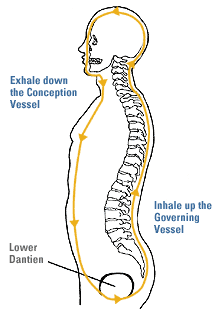The six realm theory of existence is a keystone principle in many Buddhist schools, especially the Vajrayana. Drawing from ancient cosmology, the six realms are a series of states which characterise and condition their inhabitants as Gods, Titans, Humans, Animals, Hungry Ghosts, or Hell-dwellers.
The practical worth of this system lies in its ability to parallel may of the mental states we enter throughout our lives, moment to moment. Each realm predisposes its inhabitants to particular behaviours: some make the practice of clear awareness and consciousness less hindered, while others flood beings with excesses of pain or pleasure distorting their natural flow of awareness.
Take it as a metaphor for self-evaluation; as most principles of its kind, it operates as a recipe to liberate the practitioner from conditioned states (As always, do not adhere too closely to the workings of this system or it will become habitual and hinder you more than it helps).
Here are some articles to start from:
cyberkaya
The Japanese Buddhist Statuary
BellaOnline
Buddha Dharma Education & Buddhanet
Tuesday, October 31, 2006
Wednesday, October 04, 2006
.:Notes: Sessions 4-6
Shikantaza is a useful technique in itself, but is also useful when entering other forms of focus. When you establish yourself in shikantaza, allow your focus to concentrate itself at a certain point or upon a certain object or action. This may sound paradoxical, but it happens quite readily with a little nudge of intent behind it. Remember not to force it.
This is a difficult practice, and while some are able to enter such a concentration with ease, others encounter many obstacles and much frustration. An interesting exercise to facilitate this practice 

is to link it with a light version of an ancient qi circulation technique commonly called "the microcosmic orbit". Proceed by first sitting in a confortable position and breathing slowly into the abdomen. Next, extend and relax your awareness to enter the shikantaza.
Once this state is formed, lightly bring your focus to your breathing and follow the leading front of air down to the abdominal cavity on inhalation. Suspend the in-breath for a moment. Upon exhalation, notice and follow the wave of relaxation moving outward from the abdomen and diaphragm.
In qigong and similar arts, visualization accompanies this breathing - here, refrain from any active visualization, rather, allow the awareness cultivated in shikantaza to observe the effects of the breathing in the region of the lower abdomen, cradled by the pelvis. Watch this for a considerable time.
The next stage involves the circulation of 'qi' or in our case awareness. On an in-breath, draw your awareness into the lower regions of your abdomen, referred to as the 'lower dantien' in the figure above. After the suspension of the in-breath, exhale slowly and move the awareness gently and evenly along the spinal column. Note, this is contrary to the figure due to its portrayal of the 'fire path' of the orbit. This is the 'wind-path' circulation. Once your focus has passed over the head begin another in-breath to escort it down the front of the body back to the lower dantien to complete the circle. Repeat the circuit 5-10 times. If you feel discomfort, do not use this method. At all times, your awareness and your focus should be in the 'mode' of shikantaza, ie passively but attentively watching what arises and what dissolves.
Conclude the circuit on an in-breath to the lower dantien and an out-breath following the relaxation from the diaphragm as above. Repeat this for around 20 breaths or until the momentum stops. Finally, enter the initial technique of shikantaza to stretch back into your surroundings. Hang out there for a while and be attentive to any differences.
Practicing a series of techniques like those above and paying special attention to the transitions is a starting point for skillful meditation and prevents the practioner from developing unseen 'habits' by relying too heavily on a single style.
Once this state is formed, lightly bring your focus to your breathing and follow the leading front of air down to the abdominal cavity on inhalation. Suspend the in-breath for a moment. Upon exhalation, notice and follow the wave of relaxation moving outward from the abdomen and diaphragm.
In qigong and similar arts, visualization accompanies this breathing - here, refrain from any active visualization, rather, allow the awareness cultivated in shikantaza to observe the effects of the breathing in the region of the lower abdomen, cradled by the pelvis. Watch this for a considerable time.
The next stage involves the circulation of 'qi' or in our case awareness. On an in-breath, draw your awareness into the lower regions of your abdomen, referred to as the 'lower dantien' in the figure above. After the suspension of the in-breath, exhale slowly and move the awareness gently and evenly along the spinal column. Note, this is contrary to the figure due to its portrayal of the 'fire path' of the orbit. This is the 'wind-path' circulation. Once your focus has passed over the head begin another in-breath to escort it down the front of the body back to the lower dantien to complete the circle. Repeat the circuit 5-10 times. If you feel discomfort, do not use this method. At all times, your awareness and your focus should be in the 'mode' of shikantaza, ie passively but attentively watching what arises and what dissolves.
Conclude the circuit on an in-breath to the lower dantien and an out-breath following the relaxation from the diaphragm as above. Repeat this for around 20 breaths or until the momentum stops. Finally, enter the initial technique of shikantaza to stretch back into your surroundings. Hang out there for a while and be attentive to any differences.
Practicing a series of techniques like those above and paying special attention to the transitions is a starting point for skillful meditation and prevents the practioner from developing unseen 'habits' by relying too heavily on a single style.
Subscribe to:
Posts (Atom)
